Schooled while Cycling in Lesotho
Having heard rumours of alpine-like climbing and smooth, traffic-free tar roads, an intrepid bunch of cyclists set off to find the mythical asphalt of the Lesotho Highlands. Luckily for them, they had... Keith.
There’s a road near my house in Cape Town called Milner Road. It’s vicious. Milner Road is only about 30m long, but it’s really steep. Strava says the gradient on the ‘Murder On Milner’ segment is 12.3%. But Strava’s a bloody liar – it’s way steeper. Has to be. Sometimes I attempt it on my way home from a ride, but only if there’s a little juice left in my legs. And even then it’s a weaving, blood-vessel-popping effort that takes around a minute and 20 seconds to complete.
But Milner Road is nothing compared to what we came across cycling in Lesotho.
One hairpin on Moteng Pass was so steep, I thought the road above was an entirely different road. Surely our approaching sharp-righthander’s exit could not possibly be that same piece of asphalt two stories above us? Plus we’d already been climbing for a good hour or so. It was one of those WTF-am-I-doing-here moments. But let’s back-pedal to the beginning. Here’s how we got there.
A year or so earlier, while doing the Red Rock 200km gravel- bike race outside Colesberg, my mate Rob Vogel and I had met Keith Wilson. Keith organises the event; and around the fire, we got chatting to this big, amiable bloke about his business. Turns out, he also offers tours into Lesotho, with a custom 14-seater Toyota Landcruiser and a trailer that can take as many bicycles. We’d heard rumours of the Lesotho Highlands roads that the Chinese had tarred – beautifully smooth, apparently, with spectacular mountain scenery. We knew Lesotho has some great mountain biking; but this sounded like it could also be an undiscovered road-cycling paradise. And in Keith we had a guy who not only knew the area, but knew where to book accommodation, and crucially, would be our support vehicle on the route too.
As a result, seven members of our Table Mountain Bikers crew made arrangements to fly into Bloem, meet Keith and his Landcruiser, and drive through to Fouriesburg, where we’d overnight before heading into Lesotho the next morning through the Caledonspoort border post.
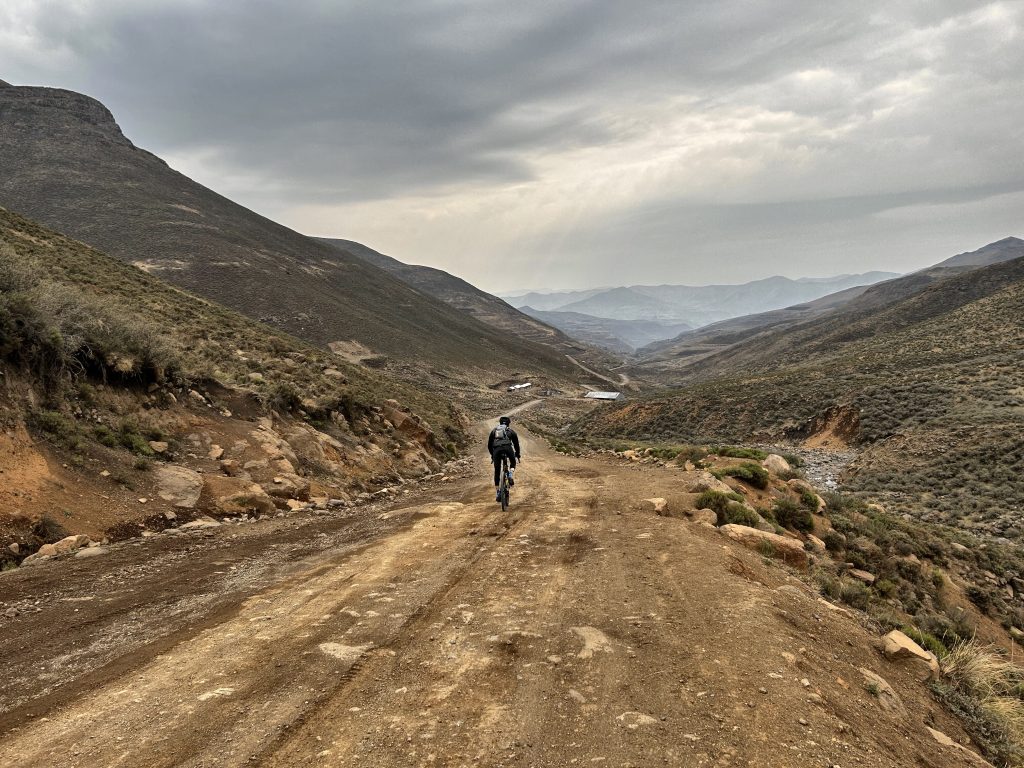
DAY 1
Our opening day was from Qalo Village just over the border, up the Moteng Pass, and overnight at the New Oxbow Lodge. Day 2 was up to the Mahlasela Pass, down past the Afriski ski lodge, and then hooking a right for a bit of a gravel section to Motebong Lodge on the upper banks of the Katse Dam. On Day 3 we’d follow the contours of the dam, up over some more smaller passes, and then end at the mighty dam wall itself. Fifty kays… 95 kays… 48 kays… it all sounded very doable. And we’re okay-ish cyclists too, with multiple Cape Epics, sub-three-hour Cycle Tours and a bunch of iconic European climbs peppering the crew’s palmares.
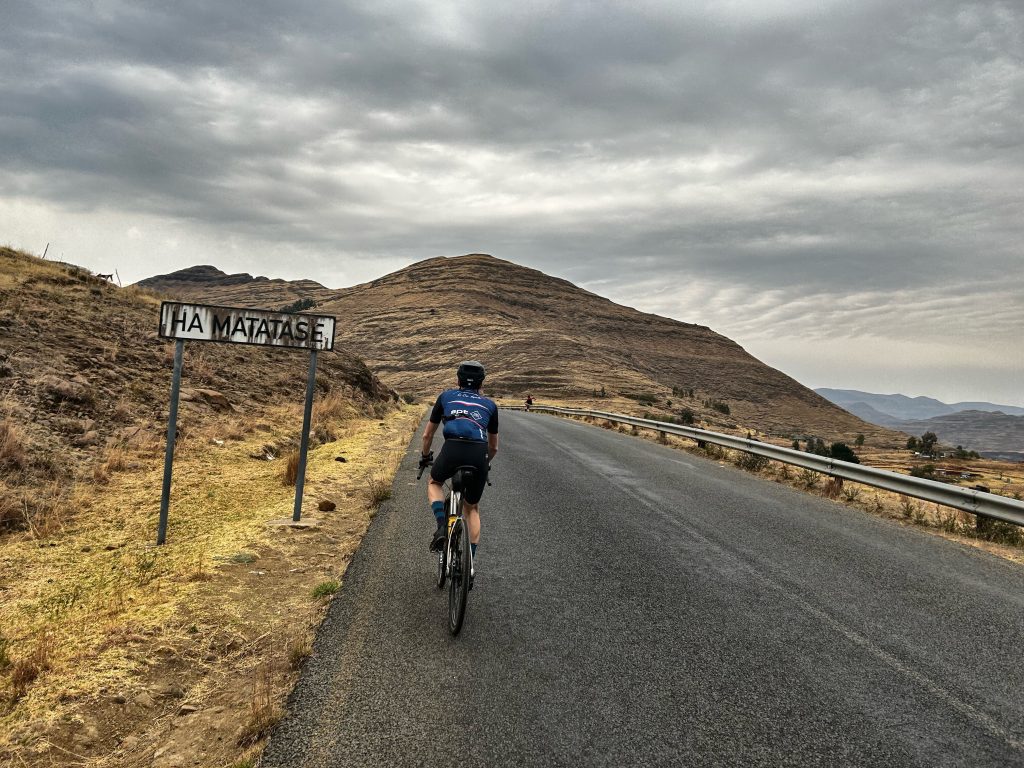
But we knew we were in for some climbing, and of course there was the altitude to deal with too – anywhere from 1 800m to 3 300m over the passes. Not ideal, for a bunch of cyclists used to drinking moist, oxygen-rich coastal air. And I’d seen a photo of Moteng Pass online (do yourself a favour and Google it). The image was a little fuzzy, but you could make out where the road traverses the mountain. The pic looked wrong, though – like it’d been shot from a funny angle. Because some of the ramps and hairpins looked way too steep for any kind of traffic to get up. My cycling brain was like, “Okay, well, it can’t really be that steep. The camera lens has distorted it.”
Because there was some gravel to ride on Day 2, and because their slacker geometry, bigger tyres and easier gearing make for easier bike touring, we were all on gravel bikes. And thank the cycling gods for that. Going back to that expletive-Moteng-Pass moment I spoke of… there’s simply no way any of us would’ve made it up the pass on road bikes, with their road-bike gear ratios.
“One hairpin on Moteng Pass was so steep, I thought the road above was an entirely different road.”
It turns out there was nothing wrong with that Moteng Pass camera angle. It’s an actual beast. You encounter 91 bends, corners and curves; among them, four extreme hairpin bends, and one full horseshoe. And all of them require your full concentration. The best analogy I can come up with is this: imagine a 15km long Ou Kaapse Weg, dotted with four or five 20% ramps (yes Strava, I said 20%). And like that horseshoe hairpin I mentioned, these sections were so steep that even on my sub-10kg Trek Checkpoint SL 5, I had to weave across the whole road to get up there. You quickly find yourself in a place even darker than your Rapha lycra. But fortunately for some, Keith and his trailer offered a welcome escape. Fifty-kay road rides don’t come
tougher than this in Southern Africa.
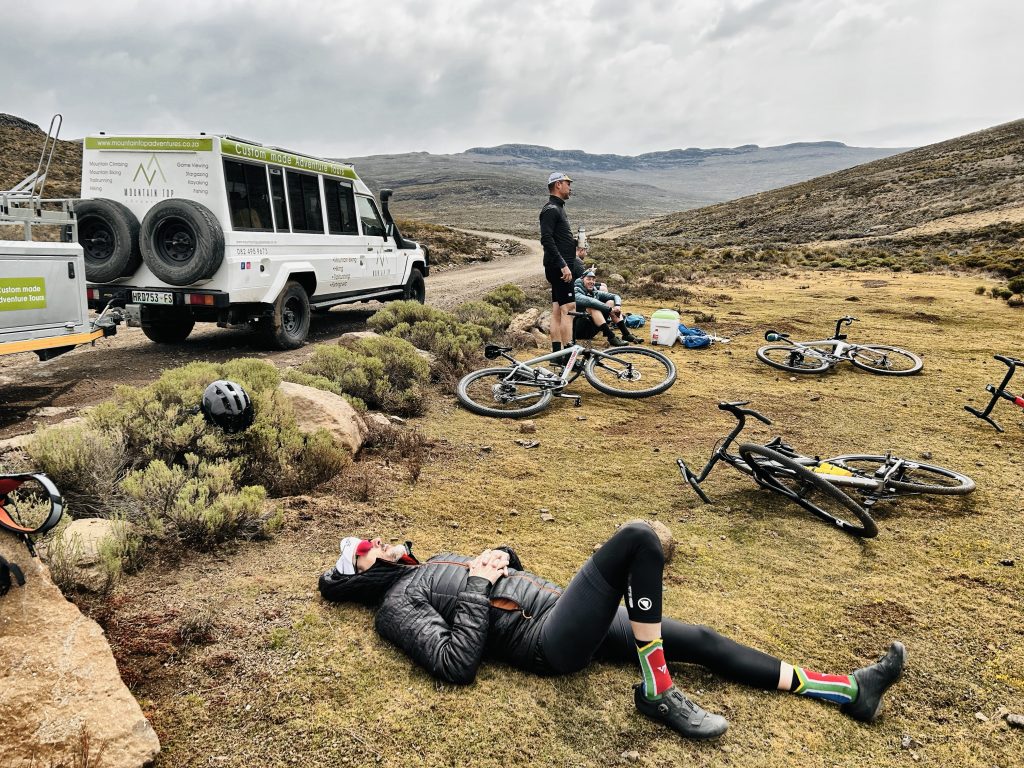
“Did you guys enjoy that?” said Keith with a chuckle, as he braaied our steaks that night. By then, what would’ve been a hard ‘no’ earlier had dissolved into a begrudging ‘yes’. Medium-rare rump, a few Maluti Lagers and a sense of achievement can do that to a person.
DAY 2
It was just as well we’d enjoyed Day 1 ; because Day 2 required a healthy dose of optimism from the outset. We turned right out of the New Oxbow Lodge’s gate, and headed straight up the Mahlasela Pass. It’s not as steep or as long as Moteng – 10km, 82 bends, one 17% ramp – but it’s pretty draggy, especially when your legs are cold. And it’s still pretty cold there in September. The nights and mornings are winter-kit chilly, though it does warm up a bit during the day.
That climb is rewarded with a fantastic descent past Afriski –long by SA standards, and you need to keep up the concentration levels down unfamiliar roads. There isn’t much traffic, but what there is doesn’t expect a posse of cyclists hurtling down at 70+km/h. Once or twice, the odd truck did cause some anxious moments. They weren’t the last ones either, though the anxiety that followed had nothing to do with traffic. Just past Afriski we found Keith parked on the side of the road, which was our cue to stop for some refreshment before embarking on the gravel section of the tour. “About 60km long,” said Keith. “It should be fun.” We really should have taken more notice of his careful phrasing. His quoted distance was totally accurate. What it didn’t convey was just how much climbing we would be doing. An initial long descent turned into a long, gradual, sneaky bastard of a climb – one of those where you see the summit in the far distance, measure your effort to get there… only to discover it’s not the actual summit. That can break a man’s heart. And this happened five, maybe six times. Some ‘summits’ had sections so steep, we literally had to push our bikes up.
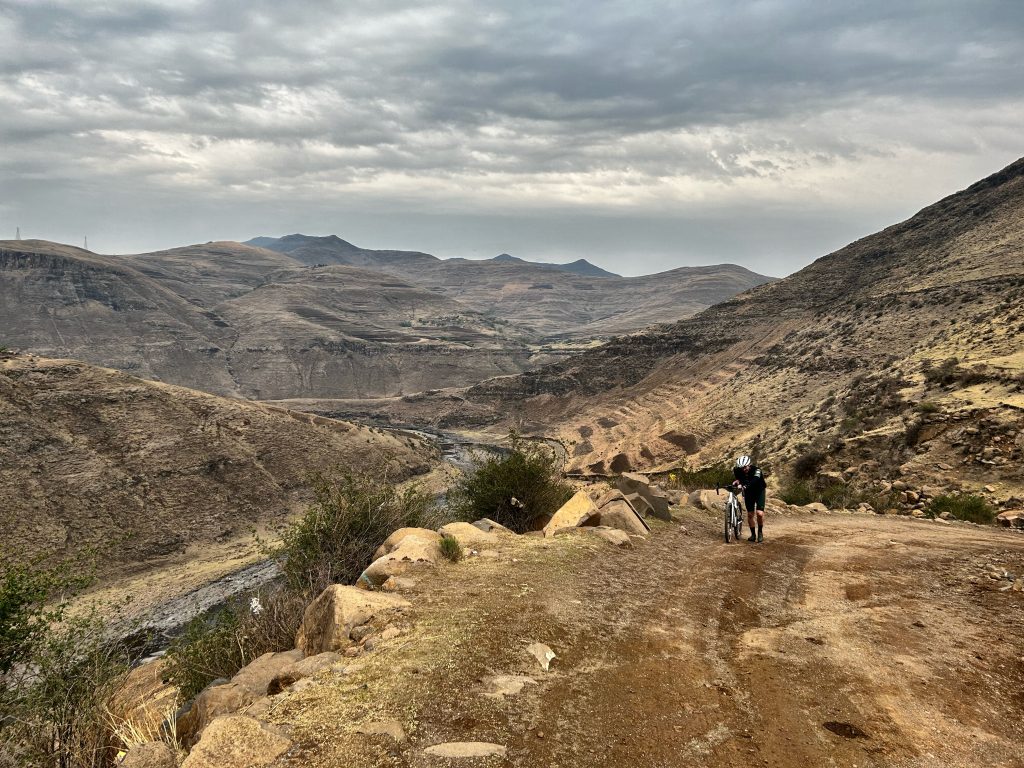
It’s really remote up there, too. You’re in the high mountains, occasionally pedalling through a small village (and once, past a huge Chinese mine, gradually gnawing away a mountain). Safety was never a concern though. While they may have been slightly perplexed as to why anyone would be on a bicycle around there, the locals were always super-friendly, and we stopped at a few village stores to top up on drinks. We also had Keith trailing us a few kays behind, ready to scoop up any technical problems or injuries.
Our lodgings that night at Motebong Lodge were simple, but clean and comfortable. The prefab units had been used to house the teams building the Katse Dam – and most importantly, the lodge was very well stocked in the Maluti Lager department. “Sorry about that, guys,” said Keith, with his now-familiar chuckle. “I hadn’t actually really driven that gravel section before – my mate had. And it looked fine on Google Maps! I definitely owe you all a cold one…”
DAY 3
We still don’t really talk about Day 3. Because of the shame. We woke up to dark skies, a little drizzle, and gusts of wind. We also woke up with pretty sore legs. And that was a combo that quickly led to a decision that most of us would regret later: we opted to stay warm in the shelter of Keith’s Landcruiser, rather than ride the 48km to the dam wall over yet more passes. All of us – except one. Jean-Baptiste. Small, lean, wiry, French; JB can’t weigh much more than a few bags of potatoes. A former national-level mountain-bike competitor in Europe, and these days,an endurance fitness coach. These formidable Lesotho passes were not much more than a Gallic shrug to this Alpine ibex. He’d left us for dead on all the climbs thus far, nibbling on rice crackers and sipping double espressos when he wasn’t smiling.
In the rain, JB set off alone on the last day. We followed in the vehicle, feeling increasingly weak-willed, as he pedalled, waved and smiled some more – all the way to the Katse Dam wall. Jean-Baptiste, you’re a legend. Chapeau, mon ami!
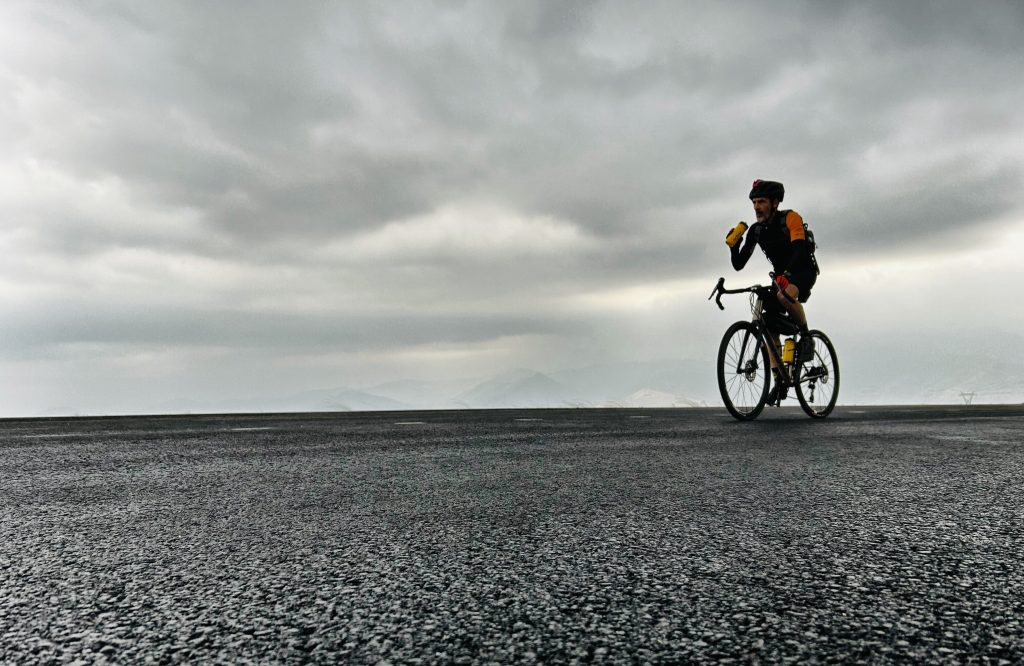
Memories
And so, our little cycling trip ended. From there we drove back to Bloem, via the Ficksburg Bridge border post. It may not have gone exactly to plan (except for JB), but our trip left some unforgettable memories for all. It’s hard riding; and there’s no doubt the altitude will affect you to some degree, if you live at the coast. But if you’re looking for a unique and special cycling adventure right on your doorstep, this is definitely one of those. Just find yourself a Keith. Having his local knowledge (and bail-out Landcruiser option) was crucial.
Cycling in Lesotho Essentials
- Bring your passport. Because it’s another country, they’ll want to stamp something.
- Bring cash. Because there are no card machines in the high mountains. The hotels and lodges take cards, but when you stop for a drink in a village, it’s cash only.
- Bring warm clothes, because Lesotho can turn on you pretty quickly. It was beanies and puffer jackets at night, and winter cycling kit in the mornings.
- Make sure your bike is ready. Because it’s steep. Have the right gears, and make sure your brakes are 100%.
- Make sure you’re ready– again, because it’s steep. And the air is thin.
- Fly Airlink. Because you’re allowed a bike bag for free. Book early though, because the prices ramp up steeply the closer you get.
- Find yourself a Keith. Or just get Keith. Because you need someone who knows. (mountaintopadventures.co.za)
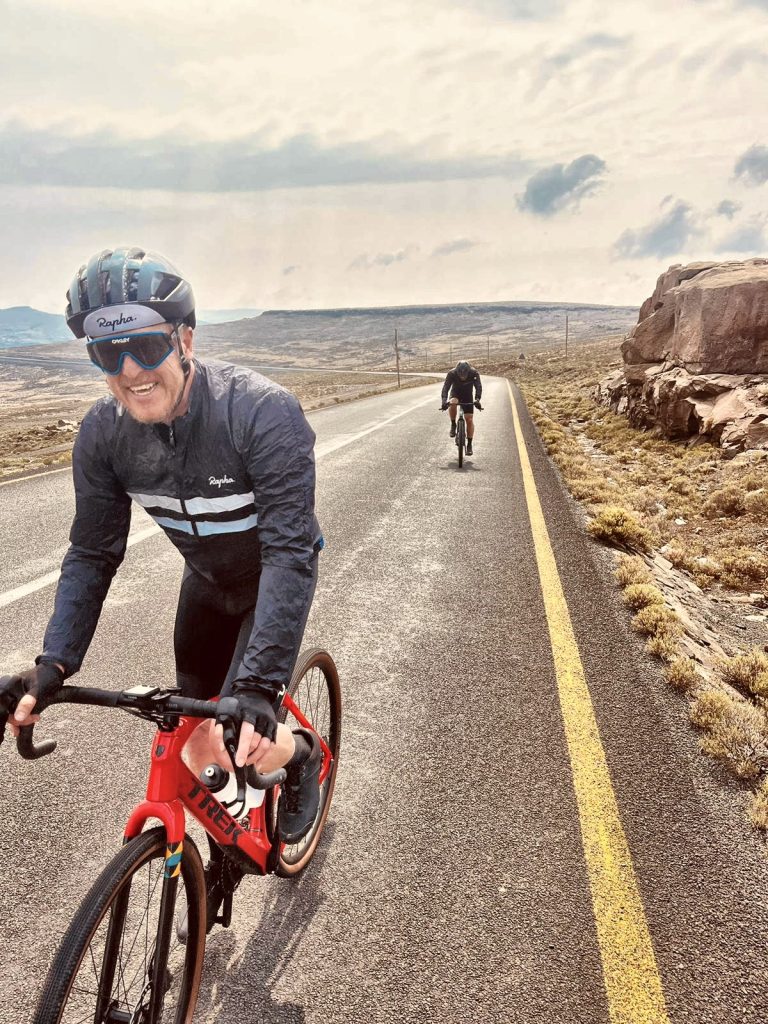 The Perfect Weapon
The Perfect Weapon
TREK CHECKPOINT SL 5
Because it’s ideal for epic all-road adventures, I chose Trek’s carbon gravel bike, with its rear IsoSpeed linkage that takes the buzz out of gravel roads. Along with internal storage, there’s also a host of integrated frame bag, rack and mudguard mounts. And you get serious tyre clearance – up to 45c.
Drivetrain: Shimano GRX RX8 11-speed
Cassette: Rear 11-34
Brakes: Shimano RX400 hydraulic disc, 160mm rotors
Wheels: Bontrager Paradigm SL
Tyres: Bontrager GR1 Team Issue 700 x 40c
READ MORE ON: Gravel Riding lesotho



